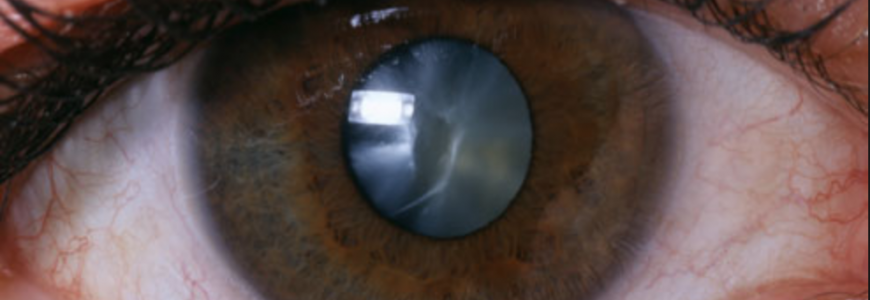
Cataract surgery facts
- Early symptoms of cataracts include blurred vision, glare, and difficulty reading.
- Cataracts will affect most people and become more prominent as we age.
- Cataracts can be diagnosed when the doctor examines the eyes with specialized viewing instruments.
- The decision to proceed with surgery is primarily based on the amount of difficulty you have performing your routine daily activities.
- Treatment for cataracts is surgical removal of the cataract with implantation of an artificial lens.
- There are a variety of intraocular lens types that can restore vision in different ways.
- Cataract surgery is a safe and effective way to restore vision with serious complications being unusual.
What is a cataract?
A cataract is an eye disease in which the normally clear lens of the eye becomes cloudy or opaque, causing a decrease in vision. The lens focuses light onto the back of the eye (the retina) so images appear clear and without distortion. The clouding of this lens during cataract formation distorts vision. Cataracts are usually a very gradual process of normal aging but can occasionally develop rapidly. They commonly affect both eyes, but it is not uncommon for a cataract in one eye to advance more rapidly. Cataracts are very common, especially among the elderly.
Precisely why cataracts occur is unknown. However, most cataracts appear to be caused by changes in the protein structures within the lens that occur over many years and cause the lens to become cloudy. Rarely, cataracts can present at birth or in early childhood as a result of hereditary enzyme defects, other genetic disease, or systemic congenital infections. Severetrauma to the eye, eye surgery, or intraocular inflammation can also cause cataracts to develop more rapidly. Other factors that may lead to development of cataracts at an earlier age include excessive ultraviolet light exposure, exposure to ionizing radiation, diabetes, smoking, or the use of certain medications, such as oral, topical, or inhaled steroids. Other medications that may be associated with cataracts include the long-term use of statins and phenothiazines.
The total number of people who have cataracts is estimated to increase to 30.1 million by 2020. When people develop cataracts, they begin to have difficulty doing activities they enjoy. Some of the most common complaints include difficulty driving at night, reading, or traveling. These are all activities for which clear vision is essential.
What are the symptoms and signs of cataracts?
Cataract development is like looking through a dirty windshield of a car or smearing grease over the lens of a camera. Cataracts may cause a variety of complaints and visual changes, including blurred vision, difficulty with glare (often with bright sun or automobile headlights while driving at night), dull color vision, increased nearsightedness accompanied by frequent changes in eyeglass prescription, and occasionally, double vision in one eye. A change in glasses may initially help once vision begins to change from a cataract. However, as the cataract continues to become denser, vision also becomes more cloudy, and stronger glasses or contact lenseswill no longer improve sight.
Cataracts typically develop gradually and are usually not painful or associated with any eye redness or other symptoms unless they become extremely advanced. Rapid and/or painful changes in vision raise suspicion for other eye diseases and should be evaluated by an eye-care professional.
What should one expect prior to and on the day of cataract surgery?
Prior to the day of surgery, your ophthalmologist will discuss the steps that will occur during surgery. Your ophthalmologist or a staff member will ask you a variety of questions about your medical history and perform a brief physical exam. You should discuss with your ophthalmologist which, if any, of your routine medications you should avoid prior to surgery. Prior to surgery, several calculations will be made to determine the appropriate power of intraocular lens to implant. A specific artificial lens is chosen based on the length of the eye and the curvature of the cornea (the clear portion of the front of the eye).
It is important to remember to follow all of your preoperative instructions, which will usually include not eating or drinking anything after midnight the day prior to your surgery. As cataract surgery is an outpatient procedure, arrangements should be made with family or friends to transport you home after the surgery is complete. Most cataract surgery occurs in either an ambulatory surgery center or a hospital. You will be required to report several hours before the scheduled time for your surgery. You will meet with theanesthesiologist who will work with the ophthalmologist to determine the type of sedation that will be necessary. Most cataract surgery is done with only minimal sedation without having to put you to sleep. Numbing drops or an injection around the eye will be used to decrease sensation of the eye.
During the actual procedure, there will be several people in the operating room in addition to your ophthalmologist. These include anesthesiologists and operating-room technicians. While cataract surgery does not normally involve a significant amount of pain, medications are used to minimize the amount of discomfort. The actual removal of the clouded lens will take approximately 20 minutes. You may notice the sensation of pressure from the various instruments used during the procedure. After leaving the operating room, you will be brought to a recovery room where your doctor will prescribe several eyedrops that you will need to take for a few weeks postoperatively. While you may notice some discomfort, most patients do not experience significant pain following surgery; if you do you experience decreasing vision or significant pain, you should contact your ophthalmologist immediately.
What should one expect after the cataract surgery?
Following surgery, you will need to return for visits within the first few days and again within the first few weeks after surgery. During this time period, you will be using several eyedrops which help protect against infection and inflammation. Within several days, most people notice that their vision is improving and that they are able to return to work. During the several office visits that follow, your doctor will monitor for complications. Once vision has stabilized, your doctor will fit you with glasses if needed. The type of intraocular lens you have implanted will determine to some extent the type of glasses required for optimal vision.
What are potential complications of cataract surgery?
While cataract surgery is one of the safest procedures available with a high rate of success, rare complications can arise. Your ophthalmologist will discuss the specific potential complications of the procedures that are unique to your eye prior to having you sign a consent form. The most common difficulties arising after surgery are persistent inflammation, changes in eye pressure, infection, or swelling of the retina at the back of the eye (cystoid macular edema), and retinal detachment. If the delicate bag the lens sits in is injured, then the artificial lens may need to be placed in a different location. In some cases, the intraocular lens moves or does not function properly and may need to be repositioned, exchanged, or removed. All of these complications are rare but can lead to significant visual loss; thus, close follow-up is required after surgery. If you have pre-existing macular degeneration or floaters, these will not be made better by cataract surgery.
In some cases, within months to years after surgery, the thin lens capsule may become cloudy, causing blurred vision after cataract surgery. You may have the sensation that the cataract is returning because your vision is becoming blurry again. This process is termed posterior capsular opacification, or a “secondary cataract.” To restore vision, a laser is used in the office to painlessly create a hole in the cloudy bag. This procedure takes only a few minutes in the office, and vision usually improves rapidly.
Other Services

If you Have Any Questions We are Here!! DON'T HESITATE TO CONTACT US ANY TIME.
Have a question? Call us now
044 - 26182803, 26186500, 42550333 & 9840174184
Drop Us an Email
info@shivaseyecare.in
About Shivas Eye Care
We opened in the year 2002 and have been providing excellent consultation for 16 years now. Our passion is to continue offering the best eye care services in Chennai. With over 50000 eye surgeries of all types in our experience, we are extremely confident of giving you excellent service in the field of eye care. No matter what your Eye related problem is, book an appointment with our clinic to get good consultation.
Our Timings:
Mon - Sat: 10 am - 1 pm & 4.30 pm - 8.00 pm
Sun: 10am - 12pm
Our Location
Address
Plot no. 1818 (New no.134), 13th Main Road, Anna Nagar, Chennai - 600040
Phone
044 - 2618-2803 or 044 - 2618-6500
Email
info@shivaseyecare.in
